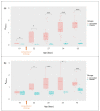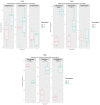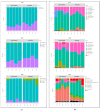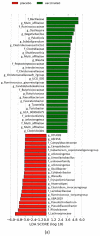Impact of DNA Prime/Protein Boost Vaccination against Campylobacter jejuni on Immune Responses and Gut Microbiota in Chickens
- PMID: 35746589
- PMCID: PMC9231206
- DOI: 10.3390/vaccines10060981
Impact of DNA Prime/Protein Boost Vaccination against Campylobacter jejuni on Immune Responses and Gut Microbiota in Chickens
Abstract
Campylobacteriosis is reported to be the leading zoonosis in Europe, and poultry is the main reservoir of Campylobacter. Despite all the efforts made, there is still no efficient vaccine to fight this bacterium directly in poultry. Recent studies have reported interactions between the chicken immune system and gut microbiota in response to Campylobacter colonisation. The present study was designed to analyse in more depth the immune responses and caecal microbiota following vaccination with a DNA prime/protein boost flagellin-based vaccine that induces some protection in specific-pathogen-free White Leghorn chickens, as shown previously. These data may help to improve future vaccination protocols against Campylobacter in poultry. Here a vaccinated and a placebo group were challenged by C. jejuni at the age of 19 days. A partial reduction in Campylobacter loads was observed in the vaccinated group. This was accompanied by the production of specific systemic and mucosal antibodies. Transient relatively higher levels of Interleukin-10 and antimicrobial peptide avian β-defensin 10 gene expressions were observed in the vaccinated and placebo groups respectively. The analysis of caecal microbiota revealed the vaccination's impact on its structure and composition. Specifically, levels of operational taxonomic units classified as Ruminococcaceae and Bacillaceae increased on day 40.
Keywords: Campylobacter jejuni caecal colonisation; caecal microbiota composition; flagellin antigen; innate immunity; poultry; systemic and mucosal immune response.
Conflict of interest statement
The authors declare no conflict of interest. The funders had no role in the design of the study; in the collection, analysis, or interpretation of data; in the writing of the manuscript, or in the decision to publish the results.
Figures









Similar articles
-
Plasmid DNA Prime/Protein Boost Vaccination against Campylobacter jejuni in Broilers: Impact of Vaccine Candidates on Immune Responses and Gut Microbiota.Pharmaceutics. 2023 May 3;15(5):1397. doi: 10.3390/pharmaceutics15051397. Pharmaceutics. 2023. PMID: 37242639 Free PMC article.
-
Evaluation of Two Recombinant Protein-Based Vaccine Regimens against Campylobacter jejuni: Impact on Protection, Humoral Immune Responses and Gut Microbiota in Broilers.Animals (Basel). 2023 Dec 7;13(24):3779. doi: 10.3390/ani13243779. Animals (Basel). 2023. PMID: 38136816 Free PMC article.
-
Research Note: Analysis of immune responses in broilers after vaccination against Campylobacter jejuni.Poult Sci. 2023 Apr;102(4):102510. doi: 10.1016/j.psj.2023.102510. Epub 2023 Jan 20. Poult Sci. 2023. PMID: 36764139 Free PMC article.
-
Re-thinking the chicken-Campylobacter jejuni interaction: a review.Avian Pathol. 2018 Aug;47(4):352-363. doi: 10.1080/03079457.2018.1475724. Epub 2018 Jun 11. Avian Pathol. 2018. PMID: 29764197 Review.
-
A tolerogenic mucosal immune response leads to persistent Campylobacter jejuni colonization in the chicken gut.Crit Rev Microbiol. 2012 Feb;38(1):17-29. doi: 10.3109/1040841X.2011.615298. Epub 2011 Oct 13. Crit Rev Microbiol. 2012. PMID: 21995731 Review.
Cited by
-
Regulatory Effects of the Probiotic Clostridium butyricum on Gut Microbes, Intestinal Health, and Growth Performance of Chickens.J Poult Sci. 2023 May 3;60(2):2023011. doi: 10.2141/jpsa.2023011. eCollection 2023. J Poult Sci. 2023. PMID: 37143616 Free PMC article. Review.
-
Campylobacteriosis and Control Strategies against Campylobacters in Poultry Farms.J Microbiol Biotechnol. 2024 May 28;34(5):987-993. doi: 10.4014/jmb.2311.11045. Epub 2024 Jan 15. J Microbiol Biotechnol. 2024. PMID: 38719774 Free PMC article. Review.
-
The role of the gut microbiota in regulating responses to vaccination: current knowledge and future directions.FEBS J. 2025 Mar;292(6):1480-1499. doi: 10.1111/febs.17241. Epub 2024 Aug 5. FEBS J. 2025. PMID: 39102299 Free PMC article. Review.
-
Application of a liposomal subunit vaccine in chickens for reduction of Campylobacter gut colonisation.J Vet Res. 2024 Nov 6;68(4):487-496. doi: 10.2478/jvetres-2024-0062. eCollection 2024 Dec. J Vet Res. 2024. PMID: 39776683 Free PMC article.
-
Plasmid DNA Prime/Protein Boost Vaccination against Campylobacter jejuni in Broilers: Impact of Vaccine Candidates on Immune Responses and Gut Microbiota.Pharmaceutics. 2023 May 3;15(5):1397. doi: 10.3390/pharmaceutics15051397. Pharmaceutics. 2023. PMID: 37242639 Free PMC article.
References
-
- Hue O., Allain V., Laisney M.-J., Le Bouquin S., Lalande F., Petetin I., Rouxel S., Quesne S., Gloaguen P.-Y., Picherot M., et al. Campylobacter Contamination of Broiler Caeca and Carcasses at the Slaughterhouse and Correlation with Salmonella Contamination. Food Microbiol. 2011;28:862–868. doi: 10.1016/j.fm.2010.11.003. - DOI - PubMed
Grants and funding
LinkOut - more resources
Full Text Sources

